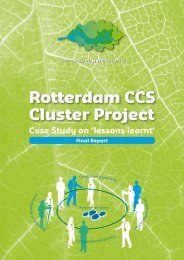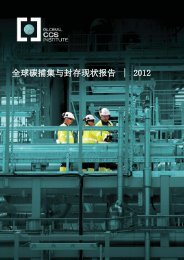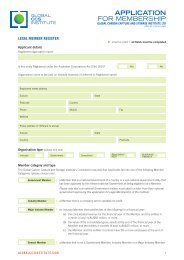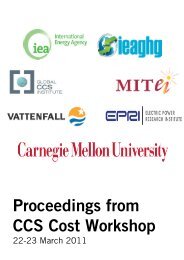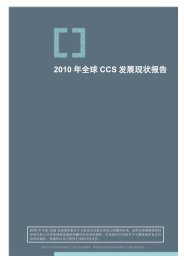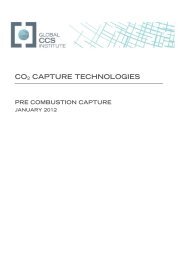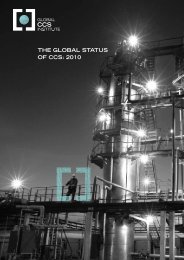Perceptions of CO2 Report - Global CCS Institute
Perceptions of CO2 Report - Global CCS Institute
Perceptions of CO2 Report - Global CCS Institute
- No tags were found...
You also want an ePaper? Increase the reach of your titles
YUMPU automatically turns print PDFs into web optimized ePapers that Google loves.
4 Qualitative investigationHistorically, lack <strong>of</strong> knowledge about <strong>CCS</strong> has led to methodological issues for <strong>CCS</strong> researchers,in that it is <strong>of</strong>ten difficult to assess attitudes towards a technology <strong>of</strong> which research participantshave little knowledge. As a result, some researchers are adopting methods that providerespondents with information about <strong>CCS</strong> at the time data is gathered (see e.g. Duan, 2010;Palmgren, et al., 2005).This project’s qualitative research component aimed to explore public perceptions <strong>of</strong> CO 2 andidentify common themes and attributes that would then inform the follow-up survey. An exploratoryprocess was used in the interviews and focus groups. In each <strong>of</strong> the three countries, 18 one-hourinterviews were conducted with participants from varied backgrounds (e.g., gender, age, educationlevel, etc.) to understand how individuals understood CO 2 . Interviews began with a series <strong>of</strong> openendedquestions regarding current knowledge and perceptions <strong>of</strong> CO 2 and <strong>CCS</strong> (as listed inAppendix A). Then, information was provided on <strong>CCS</strong>, and respondents were asked for theirthoughts on the different stages <strong>of</strong> the process. To manage potential bias in the information,scientists who are experts in the <strong>CCS</strong> field developed it through an internal review processincorporating social scientists and engineers. Next, the interviews investigated how perceptionsand understanding <strong>of</strong> CO 2 and <strong>CCS</strong> were influenced by the provision <strong>of</strong> different types <strong>of</strong>information. After information sheets were provided on where CO 2 is naturally found; commercialcommodities that are in some way related to CO 2 ; and its properties, characteristics, and behaviourincluding during <strong>CCS</strong>, interviewees were asked whether the information had changed theirperceptions and understanding <strong>of</strong> CO 2 and <strong>CCS</strong>. Interview results were analysed for commonthemes, and the information was collated to inform the material for focus groups.Two focus groups were conducted in each country. The focus groups lasted approximately 2.5hours and comprised six to eight participants from varied backgrounds (e.g. gender, age,education level, etc.). During the focus groups, participants were presented with informationsheets on <strong>CCS</strong> and CO 2 ’s characteristics and properties that had been informed by the earlierinterviews. Afterwards, they completed brief questionnaires, discussed their perceptions <strong>of</strong> <strong>CCS</strong>,and explained whether they felt that the information was important for them when forming anopinion about <strong>CCS</strong>. Additional information was then presented on the consequences <strong>of</strong> CO 2phenomena; how CO 2 behaves in <strong>CCS</strong>; and what would happen if CO 2 were to leak from pipelinesor underground storage. Participants then discussed what effect this new information had on theirperceptions <strong>of</strong> CO 2 and <strong>CCS</strong>. Further details <strong>of</strong> the focus group design can be found in AppendixB.Significant qualitative findings from all three countries were listed and classified to make a draft <strong>of</strong>the survey questionnaire. The focus group material was analysed for recurring themes andapparent country differences.Understanding how individuals perceive carbon dioxide | 9




